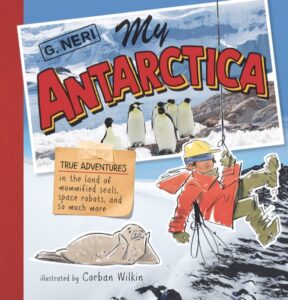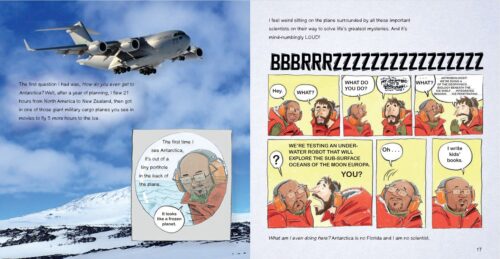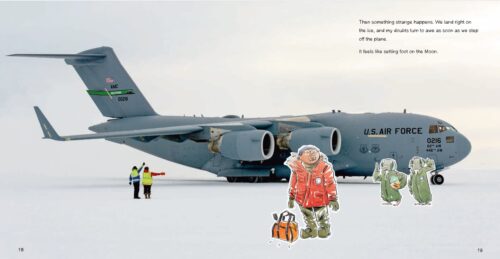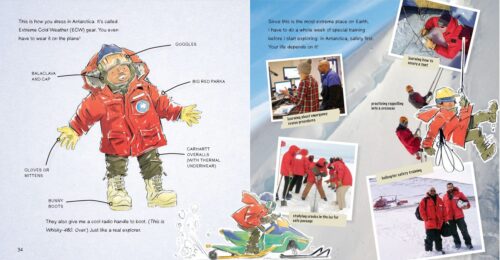Review of the Day: My Antarctica by G. Neri, ill. Corban Wilkin

The other day someone asked me a very interesting question: What were the first funny nonfiction books written for kids? This feels like it should be an easy answer, but try as I might I couldn’t really put a finger on “the first”. Was it the Magic School Bus books? The Caldecott winner So You Want to Be President? Or does it go much further back than that? Perhaps it was those old Let’s Read and Find Out books published back in the day. Those had a bit of a sense of humor, right? But even if I never identify the first of the first of the first, can we all just take a moment and appreciate the sheer number of humorous, funny, urbane, and downright delightful informational books that flood our children’s bookshelves every year? Why in 2024 alone I’ve enjoyed such hilarious books for kids as Butt or Face? Revenge of the Butts by Kari Lavelle, If I Were a Fungus by Gaia Stella, and The Wonderful Wisdom of Ants by Philip Bunting. Of course, those are all funny nonfiction picture books. If you want to look on the older side then go no further than G. Neri’s delightful, fantastic, and downright original My Antarctica. I may not know what the first funny nonfiction for kids might have been, but by gum I can at least tell you what the latest most certainly is.
He says it right at the beginning: “Somehow I managed to convince the National Science Foundation to send me to Antarctica so that I could write about the experience in a way that inspires my readers.” As G. Neri says, this is inherently ridiculous since, “(a) I live in Florida, (b) I was totally unqualified, and (c) I don’t even own winter clothes!” He is, in other words, the perfect avatar for the child reader. With wide-eyed wonder, Neri climbs aboard a giant military cargo plane in New Zealand and flies five hours to the ice (after a 21-hour trip to get there from Florida, mind you) and steps out on an alien surface. He’s taken to McMurdo Station, where he spends most of his time, and proceeds to meet the gigantic array of scientists who are already hard at work. There are scientists studying dinosaur bones, scientists testing underwater robots that will explore the sub-surface oceans of the moon Europa, scientists who count snow, and more. Through Neri’s eyes we join these scientists, join Greg on a slew of trips, and even learn a little bit about his friend who died here many years before in a diving accident. Backmatter includes many “Big Questions About Antarctica” that a person might have, an Author’s Note, Facts and Stuff (my favorite being that you cannot stay more than a year or the darkness and cold will change your body chemistry, resulting in short-term memory loss), and a Bibliography of books, films, and websites.
ADVERTISEMENT
ADVERTISEMENT

Let’s just stop a moment to appreciate how little any of us regular joes actually knows about Antarctica. Had you asked me to sketch out what it would be like to visit, I probably could have come up with some vague description of a building out there somewhere. Maybe with some scientists? But how many, I could never tell you, let alone what they’re doing or how long they stay. And that, right there, is the true joy and thrill of this book. You simply cannot turn even a single page without learning a new fact. For those of you curious, McMurdo Station is, “the main hub for US science in Antarctica. Most of the 800-1,100 Americans coming to the ice each year stay at least a week here.” The aerial view of the base (which, Neri assures us, has already been replaced with a more modern one) shows loads of buildings encompassing everything from a thrift store to a coffee house to a general hospital and even “the most remote ATM in the world.”
It would be easy, if I were Mr. Neri, to get so swept up in the sheer number of facts about Antarctica that I’d forget all about the child readers and just start listing dull adult info after a while. Yet part of the author’s great gift with this book is his ability to know how to tap into the elements that a kid would find most interesting. As a result, he never does a deep dive into any one particular scientist’s work. He might discuss their work briefly, but that’s actually a huge advantage. By doing this, he gives a sense of the sheer scope of different scientists that come to this continent. And Neri also brings up fun facts along the way, like that you can order a pizza to-go 24 hours a day because people work around the clock, or a whole series of “Icebergs Shaped Like Things” (my personal favorite is the “couch”). The end result is that he somehow manages to capture the fun as well as the awe of this singular location.

According to a brief mention made in the Acknowledgments section of the book, Greg originally envisioned that he’d turn this trip into a “ginormous graphic novel”. It was only after he kept presenting to students about this trip that he realized that he needed to instead make a, “much shorter and potent book of wonder.” Not that he didn’t also make a short graphic novel as well. Indeed, with artist Corban Wilkin the two created The Time Traveling Dino Detectives of Antarctica. But this particular book is a clear-cut success story. First off, it’s not small. Clocking in at around 10 by 10 inches, this 92-page book is filled to the brim with colorful photographs, graphs, maps, illustrations, you name it. The title page just consists of the original ad that Ernest Shackleton placed when looking for a crew (“Safe return doubtful. Honour and recognition in event of success.”). One does not credit art directors nearly enough these days, and the only person credited in the Acknowledgments is designer Carolynn DeCillo, so let’s give her a round of applause, shall we? A more kid-friendly design I haven’t seen in a long time.
Neri isn’t alone in any of this, of course. I’d like the shake the hand of whoever it was who realized that while Greg took loads of great photos of his trip, the book needed a little extra added kick. It needed, of all things, an illustrator. Corban Wilkin had worked with G. Neri before on other books (I’m ashamed to say I hadn’t recognized that he was the illustrator for Neri’s fantastic Grand Theft Horse). And he matches Neri in terms of kid-friendliness. Clearly the two were in cahoots with one another when they decided that the best way to illustrate Neri’s adventures was to have Wilkin draw him as a child. As such, early in the book Neri says, “Antarctica brings out the 10-year-od in me – like I’m discovering everything for the first time.” Once he says that, Wilkin is free to show a 10-year-old Greg traipsing about the place, exploring and learning as much as he can. It works amazingly well.

At one point in the book, Neri asks a scientist why she does what she does. She explains that when she was young, her dad’s best friend was a carpenter who would work in Antarctica, “and once, he brought me a big book about Antarctica. That book grabbed me so much, I just really got into the idea of the South Pole and everything…” I keep thinking about this moment. Neri never shies away from the fact that he’s one of the few Black guys at McMurdo Station. Maybe this book will help to change that fact in the future. After all, in making this book, Greg’s creating a new way to inspire kids to have dreams they might never have thought to have before. There’s a reason this book is called, MY Antarctica. It’s as much Greg’s as anyone’s. And his enthusiasm just bubbles off the page. You’d be helpless to resist it! Funny and hopeful, realistic and wistful, this is what I’m talking about when I say we’re seeing better nonfiction for kids these days than we’ve ever seen before. A book to inspire dreamers and scientists alike. A book you simply won’t want to miss.
On shelves now.
Source: Final copy sent from publisher for review.
Filed under: Best Books, Best Books of 2024, Review 2024, Reviews
About Betsy Bird
Betsy Bird is currently the Collection Development Manager of the Evanston Public Library system and a former Materials Specialist for New York Public Library. She has served on Newbery, written for Horn Book, and has done other lovely little things that she'd love to tell you about but that she's sure you'd find more interesting to hear of in person. Her opinions are her own and do not reflect those of EPL, SLJ, or any of the other acronyms you might be able to name. Follow her on Twitter: @fuseeight.
ADVERTISEMENT
ADVERTISEMENT
SLJ Blog Network
Endangered Series #30: Nancy Drew
Review| Agents of S.U.I.T. 2
Navigating the High School and Academic Library Policy Landscape Around Dual Enrollment Students
Read Rec Rachel: New YA May 2024
ADVERTISEMENT







